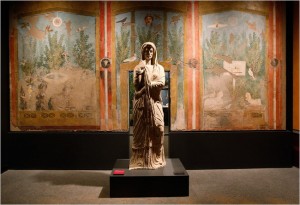 “Pompeii the Exhibit: Life and Death in the Shadow of Vesuvius” opened Friday at New York City’s Discovery Times Square museum. It boasts the largest collection of plaster body casts ever displayed at one time, plus everyday items like carbonized food and luxury items like elaborate frescoes and statuary.
“Pompeii the Exhibit: Life and Death in the Shadow of Vesuvius” opened Friday at New York City’s Discovery Times Square museum. It boasts the largest collection of plaster body casts ever displayed at one time, plus everyday items like carbonized food and luxury items like elaborate frescoes and statuary.
The body casts were first made by late 19th century archaeologist Giuseppe Fiorelli. When he was excavating Pompeii, he noticed body-shaped cavities in the volcanic stone. When Vesuvius rained pumice and ash on the town, bodies were trapped. Over time the bodies decomposed, but the cavities that had hardened around them remained intact. Fiorelli figured out he could pour liquid plaster into the cavities, then when the plaster dried, just break the pumice stone that surrounded it.
This method has left us with over a thousand whole-body death masks, basically, of Pompeiian men, women, children, dogs, even a pig, captured at the moment of death. The exhibit includes body casts of an entire family that was found together in a basement room of the House of the Gold Bracelet. The youngest child of the family was covered in such fine ash that you can actually make out his eyelashes.
Another cast in the exhibit is not from Pompeii, but from the neighboring town of Herculaneum. It’s a cast of 32 skeletons found clustered together on the seashore in 1982, nine of them children under the age of 12. Pompeii left no skeletal remains, but from 1982 to 2002, 350 skeletons would be found on the Herculaneum beach.
The exhibit doesn’t just greet you at the door with mounds of bodies, though. The idea is to give you a sense of regular life in Pompeii first. You see decorative art like frescoes and mosaics, gladiator helmets, graffiti, even a little sprinkling of erotic art discreetly tucked away in corners.
Then you walk into a bare room and the doors close behind you. A timelapse representation of Vesuvius’ eruption is projected on a screen, displaying an accelerated view of the day and a half from the first pop to the final destruction of the town. As the volcanic action increases, the walls and floors vibrate to keep pace until finally it all goes dark. The walls of the room open, and you find yourself in a dark, blue-lit gallery filled with the plaster body casts.
Sure, it’s gimmicky but I cannot deny it sounds pretty awesome. The tickets are pricey ($25 for an adult). Some part of that is meant to go to maintenance for Pompeii’s crumbling sites, at least.
Here’s a video from Discovery News that shows some of the objects on display.
Wait! There’s more! :boogie:
I saw a similar exhibition at the Melbourne Museum last year (“A Day in Pompeii” – http://museumvictoria.com.au/melbournemuseum/discoverycentre/pompeii/) and I must say, it was very, very good.
The positioning of the plaster casts wasn’t so gimmicky though – the room with the plaster casts was at the very end of the exhibition and you even had the option of not entering the room, in case you were upset by it. The plaster casts were treated with respect, and there was quite a sombre atmosphere that surrounded their exhibition. I found it very sad to see them, imagining the pain and fear they must have felt during their death.
$25 is much more affordable than travelling to Pompeii itself though, and the social history aspect was really interesting. I’d highly recommend seeing it!
I saw this exhibit when it opened in Melbourne in 2009 while I was visiting as a tourist. It was absolutely fascinating.
The displays of what life was like in the city with artifacts such as glass and other items was truly amazing. You meander through quite a bit of history and culture before getting to the room with the film depicting the progression of the eruption.
When I got to the very end of the exhibition where the body casts were I recognised some of them from picture books I have read over the years.
Thank you kindly for your eye-witness reviews of the exhibit. Did the Melbourne version have moving walls and floors too?
I saw an exhibit with some of the casts, and I can’t even describe the feelings they invoke. I had to just sit down and stare for a while. They are really very moving.
I had the same reaction, Shea. I can’t think of anything else that captures the very moment of agonizing death like those molds do.
I have to report a new book on Pompeii, of an Italian author, it’s translated into English by Mar Weir: “The Prodigy of the Sistrum from Ancient Pompeii” (Franco di Mauro Editore). It’a beautiful historical novel that speaks of ancient Pompeii and connects to the modern Pompeii. There have been many positive reviews in Italy: “The impossible friendship between two women apart their 2000 years, brings to light the secret of an ancient and wonderful love that reveals the most intimate life of the past Pompeii. The rich in spirituality pages arouse emotions that revive Pompeii.” It also tell how the transparent body casts are made.
it was and awsome video cant wait to go
:skull:
:boogie:
:love:
:notworthy: